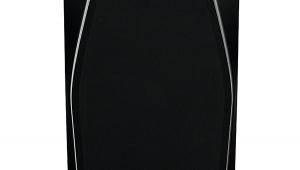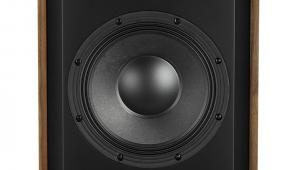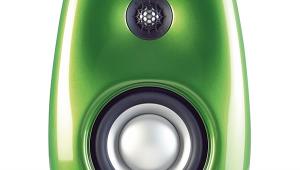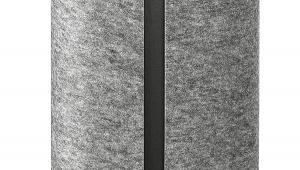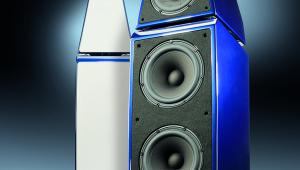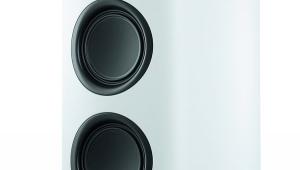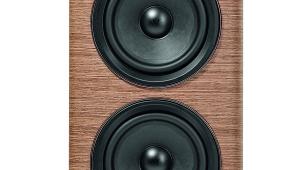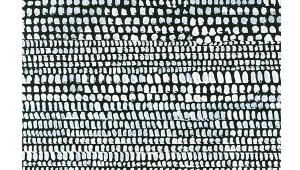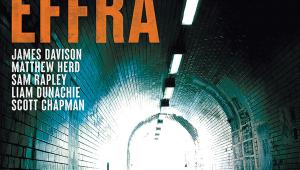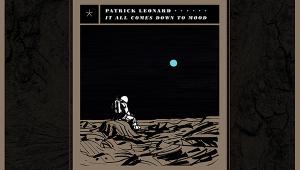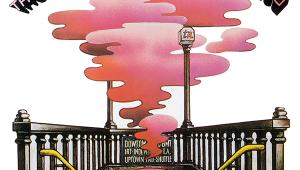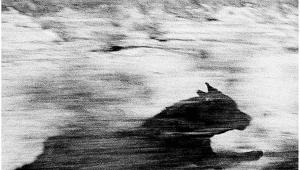Aurousal A1 Mk 2 (£645)
With the grille on, you’d guess that this was another classic British two-way speaker, though perhaps unusually well-finished. Beneath the black cloth, though, you will find just a single metal-cone driver. So is this a classic British one-way?
That drive unit is the Jordan JX92, the work of a notable designer who has spent quite a big part of his long working life perfecting full-range units.
Ted Jordan first heard a GEC 8in metal cone while working in the company’s radio lab in the very early 1950s. Later, at Goodmans, he began a serious study of cone behaviour at high frequencies, and observed that the flexing of the cone played a necessary role in the treble performance, and that a very smooth and extended response could be achieved by controlling this flexure through specific design of the cone profile.
LIGHT METAL CONES
This work resulted in the Goodmans Axiette drive unit, but Jordan felt that this still lacked the ‘life’ of the GEC metal-cone unit, and to get the best of all worlds he pursued the development of light metal cones. Leaving Goodmans in 1963, he established the Jordan Watts range of speakers, but since 1975, under the banner of E J Jordan Designs, he has specialised in supplying drive units and designs.
Kevin Warne, the man behind Aurousal, first encountered Jordan drive units when he built a pair of Jordan Watts speakers more than 25 years ago. He built many other loudspeakers as a hobbyist before starting to focus on creating a marketable hi-fi product, but in 2006 his ideas came to fruition with the Aurousal A1. This was a realisation of the 8-litre bookshelf/standmount reflex enclosure specified by Jordan.
Originally, it was expected that most users would put the speakers close to a wall or corner, gaining some bass reinforcement. However, for the Mk 2 version, Aurousal has adopted what it grandly calls ‘bass weight compensation’, using the simple passive network suggested by Jordan to rebalance the speaker, in effect increasing the bass output at the expense of sensitivity.
Sourced in the Far East, the cabinets are beautifully made, with a flared 40mm diameter port. Jordan describes this reflex cabinet design as ‘an ideal entry-level system for the smaller room’, but for larger spaces Aurousal suggests stacking two pairs of its speakers.
For listening, I put the loudspeakers on a pair of 625mm-high PMC stands, a simple, straightforward tubular steel column designed for use with the DB1+ mini speaker and bringing the Aurousal speakers to just the right height.
THE JAZZY 50'S
Before I’d really got the speakers in position, I’d put on Basie Is Back [Eighty-Eights VRCL 18833]. With the speakers pointed straight ahead, this punchy, modern live recording turned into something that reminded me of those jazz recordings made in Paris with American musicians in the 1950s – a hazy, rather distant sound image, hinting at a cavernous acoustic.
However, setting the speakers as instructed by Aurousal, with their axes crossing well in front of the listening seat resolved this, and also made the mid and treble much smoother, getting rid of a tendency to a ‘quacky’ coloration. Now there was a wide, sharply-focused and convincing stereo spread, extending behind the speakers and not audibly tied to them. Butch Miles’ drum solo on ‘Whirly-Bird’ really came to life, and I found myself loving the wonderful rhythmic qualities of the whole band.
On Diamond Days [Telarc CD-83660] the little Aurousal seemed to have a particularly happy way with Eric Bibb’s voice, clearly delineating its husky timbres rather than reducing them to a blur. Once again, the speaker’s speed and clarity seemed to release the rhythmic drive of the music, despite or perhaps because of an understated bottom end.
Turning inevitably to Kind Of Blue [Sony 480410 2] the famous bass intro to ‘So What’ lacked real weight, and so rather lost its conviction and point, and after this the walking bass that should underpin the music seemed almost incidental rather than authoritative. Instead, in my room, some notes were slightly de-emphasised while others boomed gently. This contrasted, really, with the crisply effective midrange quality, which presented all the horn players with a great sense of freshness and immediacy.
FIFTH AMENDMENT
With Beethoven’s Fifth played by the LSO under Haitink [LSO Live LSO 0590], the speaker could put forth the crescendos well, without lapsing into the grainy congested sound that this recording can often produce. There was a fundamental clarity which allowed a good feeling of the venue to come through even during loud passages. On the debit side, there was a lack of the bass weight and precision that would have given a consistent grand sense of scale, but it still sounded better here than many larger speakers I have tried.
I tried the two pairs of A1s together, stacked and connected in parallel via Aurousal’s special cable link, which includes resistors to maintain a reasonable load impedance. In my moderate-sized room, though, this didn’t produce any real benefit. The quality of its bass was not improved, although quantity was, and there was some loss of midrange purity and clarity which, combined with believable stereo imagery, is the speaker’s great strength.
While the bigger MJ Acoustics S1R [HFN Oct ’06], using Jordan’s transmission-line system design, can produce more extended bass, it needs a very big amp to do this effectively. The little Aurousal A1’s bass output is still extended relative to the size of the drive unit and enclosure, but this bass can still lack conviction. Yet this limitation is forgivable for its otherwise highly dynamic and coherent style of music-making, even at moderate volumes. If your priorities lie in this direction, then the Aurousal can be warmly recommended.
VERDICT
The Aurousal does deliver much of what is claimed given care with positioning, though it shouldn’t be relied on to produce the seduction hinted at by Aurousal’s advertising. The A1 Mk 2 reviewed here has been adjusted to have more bass than the original A1, but the bottom end remains its weakest point. Otherwise, it produces a fresh, enjoyable sound.
Originally published in the April 2008 issue







